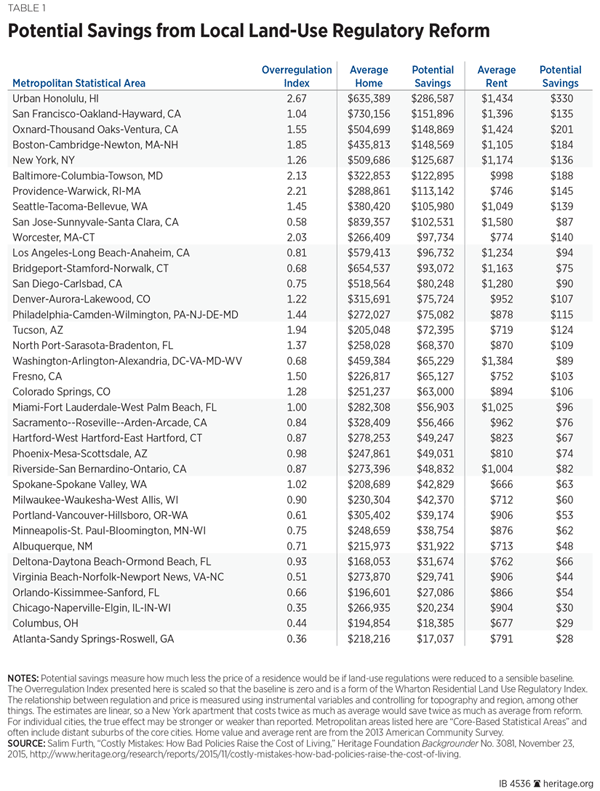Americans who are struggling to pay their bills or to increase their standard of living would get a big lift if local governments around the country reduced the regulation of land use and strengthened individual property rights. Too many local governments have bought into the harmful ideas that cities and suburbs ought to be “planned” by experts and that new construction generally imposes a net cost on other residents. In addition to saving money, less regulation would promote upward mobility and economic growth by making it easier for Americans to move to high-wage cities.
Reforming residential land-use regulation would save American households $209 billion a year.[1] For the average household, that works out to $1,700 to add to retirement savings or spend on current needs. In addition, lower housing costs would allow more working-class families to move to areas with high-paying jobs.
Lowering the Barriers to Building
Overregulation of land use comes in several forms:
- Zoning laws. Zoning laws regulate how land can be used (commercial, residential, or industrial) and how dense it can be (e.g., height and lot size). They are usually designed to preserve the past and block the natural transitions among different uses of land. Zoning laws should be loosened to allow most types of building in most places. A pharmacy should not need special permission to be built on a busy corner, nor should townhouses be forbidden in suburban neighborhoods.
- NIMBYism. Local governments often face pressure from citizens who do not mind construction in theory but “not in my backyard.” Neighborhood review is appropriate for government projects that propose to alter public spaces such as roadways, but neighbors should not be allowed to veto private building projects simply because they dislike them. Each additional permit and paperwork barrier allows opponents of affordability to keep rents high.
- Environmental review delays. A primary cost of environmental review, which often involves state and federal agencies, is the delay it imposes on construction projects. While a delay may appear trivial to outsiders, it represents time that funds must sit, earning nothing and waiting for the right signatures. The delays add costs to some projects and forestall others altogether, decreasing the supply of structures and raising rents. In places that are already urban, environmental review should be used only in special cases. Otherwise, any project that follows existing environmental laws should be approved automatically.
What About Current Homeowners?
The most common objection to reducing land-use regulation in urban and suburban areas is that current homeowners might lose money. It comes as a surprise to most that lower regulation can be a financial win-win for current homeowners as well as for prospective buyers. Studying areas as diverse as Massachusetts and Florida, researchers have found that a modest decrease in land-use regulation increases the value of most existing properties at the same time that it makes housing cheaper.[2]
How is that possible? With less regulation, housing becomes cheaper but land becomes more valuable, since the owner gains more extensive property rights. For example, imagine that someone owns a $600,000 house on a quarter acre of land. With restrictive zoning, he could sell for $600,000, and one new buyer would be able to move in—at a high cost. But with consumer-friendly zoning, he could subdivide, build a second house on the lot, and sell each one for $450,000. If the construction costs of the new house are $200,000, the original owner walks away with an extra $100,000, and two new families can move to the neighborhood, each at $150,000 less than before. The neighbors win too: Even without subdividing their own lots, their property values have risen from $600,000 to $700,000.
To be sure, there are people who profit from high regulation. Obvious examples are apartment building and condominium owners, who own lots of housing but little land.
Unequal Impact
Home buyers and renters in rural areas and most Southern and Midwestern cities already enjoy permissive land-use regulations, although there is almost always room for small improvements. But in other parts of the country—especially the elite coastal cities—regulatory reform would make it much easier for middle-class families with children to remain in the area.
As Table 1 shows, the largest potential savings from regulatory reform are in Honolulu, where the average home price was an eye-popping $635,000 in 2013. With modest regulatory reforms, an average home would instead be “just” $349,000—still far more than the national average but not completely out of reach for middle-income families. Likewise, the average renter in Honolulu would save $330 a month with regulatory reform.
The other areas with huge potential savings are on the West Coast and along the East Coast’s “Acela Corridor.” Metropolises in Florida, Colorado, and Arizona round out the top 25 areas for highest potential savings.
Become a Magnet
There is no one-shot solution to overregulation of land use. Thousands of regulations maintained by thousands of municipalities across the country are the hedge between consumers and low housing prices. Any single city, town, or county, however, can move on its own to simplify its rules and reap the rewards. Likewise, more restrictive states, such as California and Colorado, can ease their environmental review rules for urban development, rules that have pushed people away from cities and into former farmland.
Allowing newer, denser development would raise property values and local revenues in most cases. New buildings attract high-revenue businesses and upwardly mobile residents. This is especially true when the surrounding region is restrictive and there is pent-up demand for high-quality residential and commercial space. Action, however, takes the courage to do things differently: to drop rules and regulations that are common and give up the conceit that planners know best.
—Salim Furth, PhD, is Research Fellow in Macroeconomics in the Center for Data Analysis, of the Institute for Economic Freedom and Opportunity, at The Heritage Foundation..



